Using two labels in an AnchorPane should work.
(Update: Following @kleopatra's suggestion, I incorporated a DecimalFormat into this solution, which will (at least partially) localize the currency symbol, as well as the number of decimal digits, etc. This will make the assumption that the currency symbol is displayed to the left of the currency value, which isn't necessarily true for all currencies, but the assumption is somewhat implicit in the question anyway.)
public class PriceTableCell<S> extends TableCell<S, Long> {
private final AnchorPane pane ;
private final Label valueLabel ;
// locale-aware currency format to use for formatting
private DecimalFormat format;
public PriceTableCell() {
// grab an instance
format = (DecimalFormat) NumberFormat.getCurrencyInstance();
//get the currency symbol
String symbol = format.getCurrency().getSymbol();
// replace the currency symbol with an empty string
DecimalFormatSymbols symbols = format.getDecimalFormatSymbols();
symbols.setCurrencySymbol("");
format.setDecimalFormatSymbols(symbols);
Label currencySignLabel = new Label(symbol);
valueLabel = new Label();
pane = new AnchorPane(currencySignLabel, valueLabel);
AnchorPane.setLeftAnchor(currencySignLabel, 0.0);
AnchorPane.setRightAnchor(valueLabel, 0.0);
setContentDisplay(ContentDisplay.GRAPHIC_ONLY);
}
@Override
protected void updateItem(Long price, boolean empty) {
super.updateItem(price, empty);
if (empty) {
setGraphic(null);
} else {
// manual formatting
//String text = String.format("%,d.%02d", price / 100, Math.abs(price % 100));
valueLabel.setText(format.format(price));
setGraphic(pane);
}
}
}
Here is a SSCCE:
import java.text.DecimalFormat;
import java.text.DecimalFormatSymbols;
import java.text.NumberFormat;
import java.util.Random;
import java.util.function.Function;
import javafx.application.Application;
import javafx.beans.property.LongProperty;
import javafx.beans.property.SimpleLongProperty;
import javafx.beans.property.SimpleStringProperty;
import javafx.beans.property.StringProperty;
import javafx.beans.value.ObservableValue;
import javafx.scene.Scene;
import javafx.scene.control.ContentDisplay;
import javafx.scene.control.Label;
import javafx.scene.control.TableCell;
import javafx.scene.control.TableColumn;
import javafx.scene.control.TableView;
import javafx.scene.layout.AnchorPane;
import javafx.stage.Stage;
public class TableViewWithAccountingStyleCell extends Application {
public static class PriceTableCell<S> extends TableCell<S, Long> {
private final AnchorPane pane ;
private final Label valueLabel ;
// locale-aware currency format to use for formatting
private DecimalFormat format;
public PriceTableCell() {
// grab an instance
format = (DecimalFormat) NumberFormat.getCurrencyInstance();
//get the currency symbol
String symbol = format.getCurrency().getSymbol();
// replace the currency symbol with an empty string
DecimalFormatSymbols symbols = format.getDecimalFormatSymbols();
symbols.setCurrencySymbol("");
format.setDecimalFormatSymbols(symbols);
Label currencySignLabel = new Label(symbol);
valueLabel = new Label();
pane = new AnchorPane(currencySignLabel, valueLabel);
AnchorPane.setLeftAnchor(currencySignLabel, 0.0);
AnchorPane.setRightAnchor(valueLabel, 0.0);
setContentDisplay(ContentDisplay.GRAPHIC_ONLY);
}
@Override
protected void updateItem(Long price, boolean empty) {
super.updateItem(price, empty);
if (empty) {
setGraphic(null);
} else {
// manual formatting
//String text = String.format("%,d.%02d", price / 100, Math.abs(price % 100));
valueLabel.setText(format.format(price));
setGraphic(pane);
}
}
}
public static class Item {
private final StringProperty name = new SimpleStringProperty();
private final LongProperty price = new SimpleLongProperty();
public Item(String name, long price) {
setName(name);
setPrice(price);
}
public StringProperty nameProperty() {
return name ;
}
public final String getName() {
return nameProperty().get();
}
public final void setName(String name) {
nameProperty().set(name);
}
public LongProperty priceProperty() {
return price ;
}
public final long getPrice() {
return priceProperty().get();
}
public final void setPrice(long price) {
priceProperty().set(price);
}
}
@Override
public void start(Stage primaryStage) {
TableView<Item> table = new TableView<>();
table.getColumns().add(column("Item", Item::nameProperty));
TableColumn<Item, Long> priceColumn = column("Price", item -> item.priceProperty().asObject());
priceColumn.setPrefWidth(300);
priceColumn.setCellFactory(tc -> new PriceTableCell<>());
table.getColumns().add(priceColumn);
Random rng = new Random();
for (int i = 1 ; i <= 20 ; i++) {
table.getItems().add(new Item("Item "+i, rng.nextInt(1_000_000)));
}
Scene scene = new Scene(table);
primaryStage.setScene(scene);
primaryStage.show();
}
private <S,T> TableColumn<S,T> column(String name, Function<S, ObservableValue<T>> property) {
TableColumn<S,T> column = new TableColumn<>(name);
column.setCellValueFactory(cellData -> property.apply(cellData.getValue()));
return column ;
}
public static void main(String[] args) {
launch(args);
}
}
which produces



